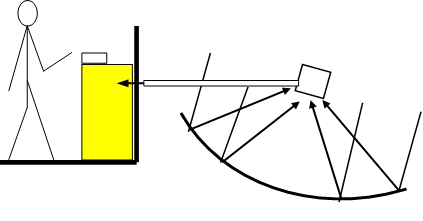Heat collection options: concentrators
Evacuated tube heaters converted to heating oil instead of water can reach high temperatures (tests at UEM, Mozambique, have reached above 170 degrees C) but still somewhat less than desired for efficient cooking.
Concentrators (trough or dish types) give high temperatures at heat
absorbers located in the focal area, depending on the concentration
ratios.
A heat storage can be located in the focal area, or positioned
separately and be interfaced with a heat transfer loop.
 |
 |
 |

|
 |
| Heat transfer to storage |
Direct heating in dish |
Double reflector |
Scheffler reflector |
CPC reflector |
- Heat transfer to storage
A heat transfer loop is needed, and we have experiences with forced convection and with natural circulation of heat transfer fluids. The solar energy transfer to the storage can also be made with a light guide, which directs the rays by internal reflection from the focal point of a reflector to the storage. - Direct heating in dish
This can be an impractical arrangement for large heat storages, as the dish needs to rotate around the storage. - Secondary reflector
A double reflector system, where a secondary reflector directs the rays to a stationary heat storage below the primary reflector has been tested with a PCM storage unit. The idea is then to have portable storage units to give cooking energy for one meal. - Scheffler reflector
The Scheffler reflector is a clever design (ref. Scheffler) where a dish is made from a cut-out of the side of a parabolic dish. the reflector can then focus on a stationary point (which can be through a hole in a wall), during the solar tracking (which is rotation of a polar mount axis).
We have not worked with Scheffler reflectors, but we did a test with a rock bed dryer, where a Scheffler reflector was simulated with lamps in the laboratory setting. - CPC reflector
A Compound Parabolic Reflector (CPC) has less needs for solar tracking as it has a range of acceptance angles of the solar rays. This can give a simpler system, although at the cost of low concentration ratios.